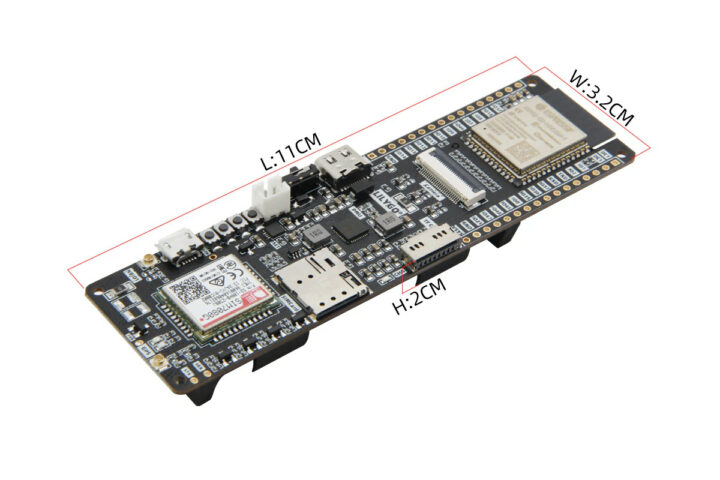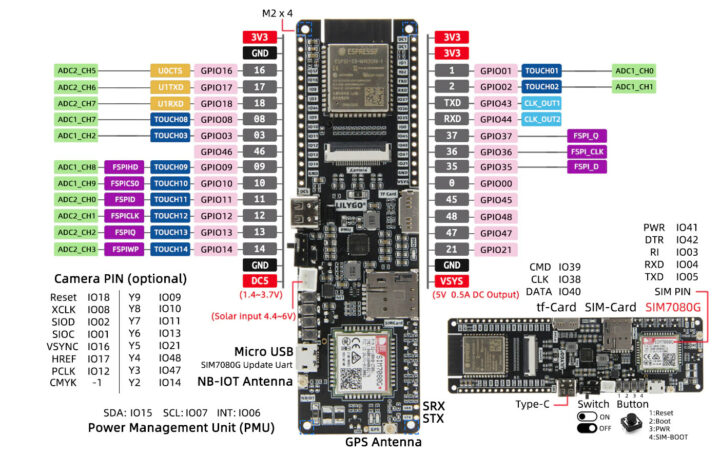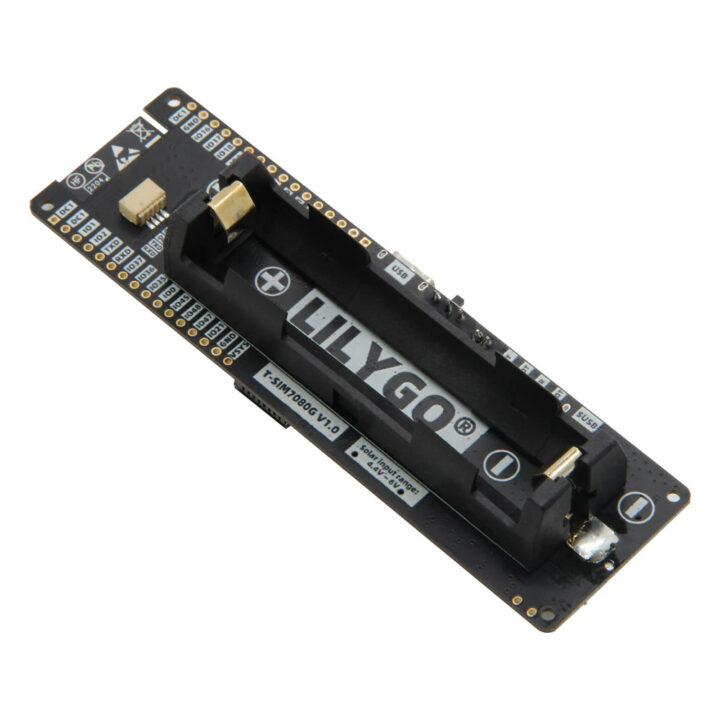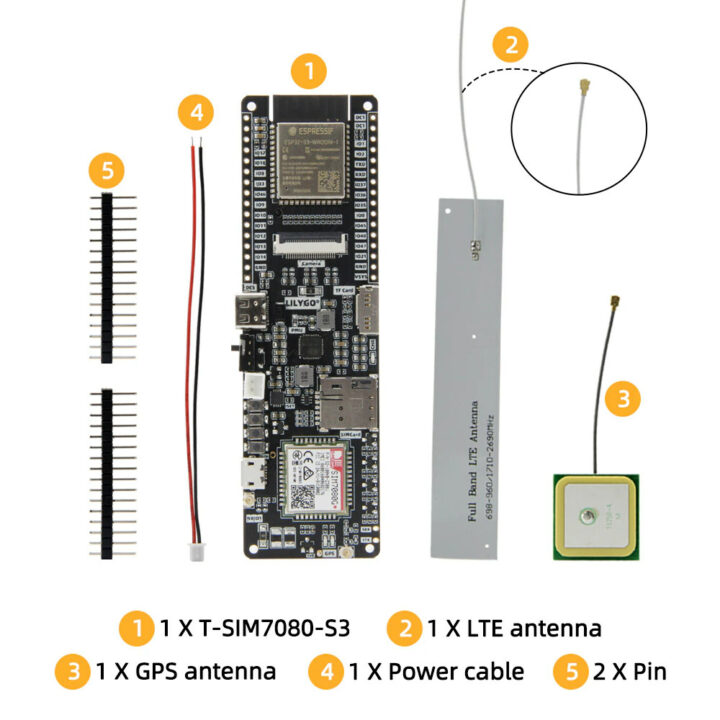LILYGO T-SIM7080G-S3 is an ESP32-S3 WiFi and Bluetooth IoT board with a SIMcom SIM7080G LTE Cat-M (eMTC), NB-IoT, and GNSS module for low-power long-range connectivity and asset tracking.
The board also comes with a 18650 battery holder, a solar panel input, a microSD card slot, a camera port, and several I/Os and provides an alternative to the TTGO T-Beam ESP32 board that relies on LoRaWAN for long-range connectivity instead.
 LILYGO T-SIM7080G-S3 specifications:
LILYGO T-SIM7080G-S3 specifications:
- Wireless modules
- Espressif ESP32-S3-WROOM-1-N16R8 module with ESP32-S3 dual-core LX7 microprocessor @ up to 240 MHz with Vector extension for machine learning, 16MB flash, 8MB PSRAM, WiFi 4 and Bluetooth 5 LE/Mesh
- SIMCom SIM7080G global multi-band Cat-M and NB-IoT module with GNSS
- Bands:
- Cat-M – B1/B2/B3/B4/B5/B8/B12/B13/B14/B18/B19/B20/B25/B26 /B27/B28/B66/B85
- NB-IoT – B1/B2/B3/B4/B5/B8/B12/B13/B18/B19/B20/B25/B26/B28 /B66/B71/B85
- Data rate
- Cat-M – Uplink: 1,119 Kbps, downlink: 589 Kbps
- NB-IoT: Uplink: 150 Kbps downlink: 136 Kbps
- LTE RF Power Class: 5 (Typ. 21dbm)
- GNSS – GPS, GLONASS, BeiDou, and Galileo
- Supply voltage – 2.7V to 4.8V
- Power consumption
- PSM: 3.2uA
- Sleep: 0.6mA @ PTW=40.96s eDRX=81.92s
- Idle: 10mA
- Dimensions – 17.6 x 15.7 x 2.4 mm
- Temperature Range – -40°C to +85°C
- Bands:
- Antennas
- PCB antenna on ESP32-S3 module for WiFi and Bluetooth
- External LTE antenna
- External GPS antenna
- SIM card slot
- Storage – MicroSD card slot
- Camera – Camera connector
- USB
- 1x USB Type-C port for power and programming (the ESP32-S3 module)
- 1x micro USB port for SIM7080G serial console
- Expansion – 2x 16-pin headers with up to 24x GPIOs, 12x ADC, SPI, touch, 2x UART, 5V, 3.3V, DCS (1.4-3.7V), and GND
- Misc
- On/off switch
- Reset, Boot, PW, and SIM-Boot buttons
- Power Supply
- 5V via USB-C port
- 18650 battery holder
- 4.4 to 6V solar panel input
- I2C PMU (Power management unit) with short circuit and overload protection
- Dimensions – 11 x 3.2 x 2 cm

For some reason, we are told the SIMCom module supports Android 5.0 and greater Radio Interface Layer (RIL) and USB drivers are available for Windows, Linux, and Android. The T-SIM7080G-S3 can be programmed in PlatformIO or the Arduino IDE and samples running on the ESP32-S3 microcontroller are provided for the camera, modem (NB-IoT and GPS), SIM7080G firmware upgrade, the PMU, as well as a few MQTT sketches. You’ll find those on GitHub along with Arduino libraries, SIM7080G datasheets, and the PDF schematics for the board.
It’s not the first time we write about an ESP32-S3 board with NB-IoT, Cat-M, and GPS support since it’s what the Walter board does except it is based on a Sequans GM02SP 5G IoT modem instead. LILYGO T-SIM7080G-S3 looks to be more cost-effective with a complete kit with the board, GPS and LTE antennas, a “power cable”, and a pair of headers going for $36.98 including shipping.

Jean-Luc started CNX Software in 2010 as a part-time endeavor, before quitting his job as a software engineering manager, and starting to write daily news, and reviews full time later in 2011.
Support CNX Software! Donate via cryptocurrencies, become a Patron on Patreon, or purchase goods on Amazon or Aliexpress







Can anyone suggest a library for working with SIM70x that does not depend on Arduino?
In my experience, these kinds of modems, Simcom, Quectel etc. are very poorly supported in terms of general libraries for them.
You’re mostly using AT commands to use each individual device. I say this because even within the same manufacturer a certain model of modem might use different AT commands that effectively do the same thing. I generally find these things to be a real pain to use at a general level.